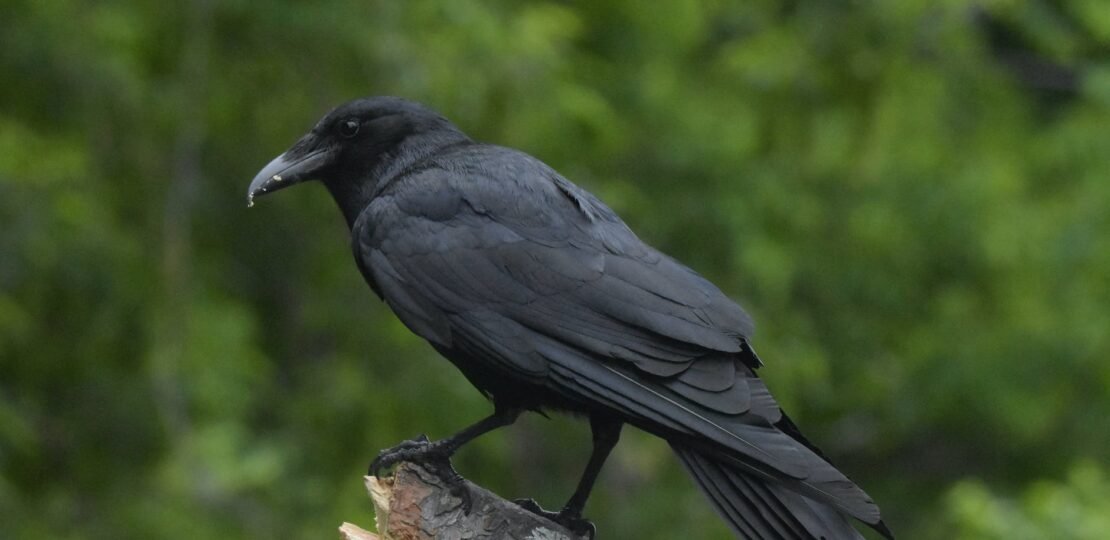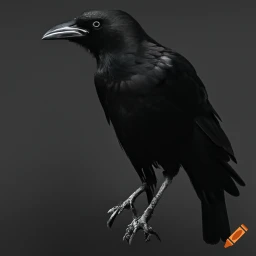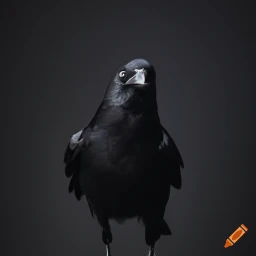Meet the Carrion Crow: Corvus Corone Linnaeus, 1758 – Eurasias Dark Avian
December 30, 2023 | by BlackCrow.com

Introduction to the Carrion Crow
The Carrion Crow (Corvus corone Linnaeus, 1758) is a bird species belonging to the crow family. This dark avian is widely distributed across Eurasia and is known for its adaptability, intelligence, and distinct vocalizations. In this section, we will provide an overview of the Carrion Crow and discuss its taxonomy and classification.
Overview of the Carrion Crow
The Carrion Crow is a medium-sized bird with a length ranging from 45 to 52 centimeters (18 to 20 inches) and a wingspan of approximately 85 to 100 centimeters (33 to 39 inches). Its black plumage is striking and gives it a distinctive appearance. This species is often confused with the closely related Hooded Crow (Corvus cornix), which has a gray body and black head.
Carrion Crows are highly adaptable and can be found in a variety of habitats, including woodlands, farmlands, urban areas, and coastal regions. They are opportunistic feeders and have a diverse diet that includes carrion, insects, small mammals, eggs, fruits, and grains. Their adaptability and scavenging nature have earned them the name “Carrion Crow.”
Taxonomy and Classification
The scientific name of the Carrion Crow is Corvus corone, and it belongs to the family Corvidae, which includes other intelligent and social birds such as ravens, magpies, and jays. The species name corone was given by Carl Linnaeus in 1758.
The Carrion Crow is part of a complex group of crow species known as the Corvus corone species complex. This complex includes several closely related species, such as the Hooded Crow (Corvus cornix), which has a similar appearance to the Carrion Crow but has a different distribution range. The taxonomy and classification of these crow species have been the subject of ongoing debate and research.
Understanding the taxonomy and classification of the Carrion Crow and its close relatives helps scientists and researchers gain insights into the evolutionary relationships and ecological roles of these birds. It also provides a framework for studying their behavior, genetics, and conservation status.
In the following sections, we will explore the physical characteristics, distribution, behavior, and conservation status of the Carrion Crow, shedding light on its fascinating characteristics and ecological significance.
Physical Characteristics
The Carrion Crow, scientifically known as Corvus corone Linnaeus, 1758, is a species of bird known for its distinctive appearance and behavior. Let’s explore the size, appearance, plumage, and coloration of this intriguing avian.
Size and Appearance
Carrion Crows are medium-sized birds, measuring approximately 17-20 inches (45-52 cm) in length. They have a wingspan of around 35-39 inches (90-100 cm). These crows have a robust build, characterized by a stout bill and strong legs.
In terms of weight, Carrion Crows generally range between 17-21 ounces (480-600 grams). However, there can be slight variations depending on factors such as sex and geographic location.
Plumage and Coloration
The plumage of the Carrion Crow is predominantly black, which gives it a sleek and glossy appearance. The feathers are dense and provide excellent insulation against varying weather conditions.
While the overall coloration is black, there may be slight variations in shades across different individuals. Some Carrion Crows may display a slight bluish or purplish sheen on their feathers when viewed under certain lighting conditions.
It’s important to note that the plumage of juvenile Carrion Crows differs slightly from that of adults. Juveniles have a duller and less glossy appearance, with a slightly lighter brownish-black coloration. As they mature, their plumage gradually darkens and takes on the characteristic glossy black color associated with adult Carrion Crows.
Understanding the physical characteristics of the Carrion Crow provides valuable insight into their identification and distinguishes them from other crow species. Their black coloration and medium-sized build make them easily recognizable in their natural habitats.
Stay tuned as we delve further into the distribution, behavior, and conservation status of the Carrion Crow, providing a comprehensive overview of this captivating bird.
Distribution and Habitat
The Carrion Crow, scientifically known as Corvus corone Linnaeus, 1758, is a species of crow that is native to Eurasia. Let’s explore the geographic range and preferred habitats of this captivating bird.
Geographic Range
The Carrion Crow has a vast geographic range that spans across Eurasia. It can be found in various countries, including but not limited to the United Kingdom, Ireland, France, Germany, Spain, Italy, Sweden, and Russia. The distribution of the Carrion Crow extends from western Europe to eastern Asia, covering a significant portion of the Eurasian continent.
Preferred Habitats
Carrion Crows are adaptable birds that can thrive in diverse habitats. They are commonly found in both rural and urban environments, including woodlands, farmlands, parks, gardens, and even urban areas. These resilient birds have successfully adapted to human-altered landscapes and can often be seen in city parks and suburban areas.
While they are adaptable in terms of habitat, Carrion Crows do show a preference for areas with open spaces, such as fields and meadows, as well as wooded areas and forests. These habitats provide them with a variety of food sources and nesting opportunities. Their ability to thrive in different habitats contributes to their widespread distribution across Eurasia.
By understanding the distribution and preferred habitats of the Carrion Crow, we can appreciate the adaptability and resilience of this species. Whether soaring through the open countryside or perched on a tree in an urban park, the Carrion Crow continues to fascinate bird enthusiasts with its presence and adaptability.
Behavior and Adaptations
The Carrion Crow exhibits fascinating behavior and adaptations that contribute to its survival and success as a species. Let’s explore its diet and feeding habits, nesting and breeding behavior, and social behavior.
Diet and Feeding Habits
The Carrion Crow is an opportunistic omnivore, displaying a versatile diet that includes both animal and plant matter. Its primary food source consists of carrion, hence its name. Carrion provides an important source of nutrients for these birds, and they play a significant ecological role by cleaning up carcasses and preventing the spread of disease.
In addition to carrion, Carrion Crows also feed on a variety of other food items. They actively hunt small mammals, birds, and insects, and scavenge for discarded human food and agricultural waste. They are known to raid the nests of other birds to feed on eggs and young chicks. Carrion Crows are also known to consume fruits, berries, and seeds when available.
Nesting and Breeding
Carrion Crows are monogamous birds that form long-term pair bonds. They typically breed once a year, with the breeding season occurring between March and July. These birds construct large nests made of sticks, twigs, and other materials, often located in tall trees or on buildings. The female Carrion Crow is primarily responsible for constructing the nest, while the male assists by providing materials.
The female lays a clutch of 3 to 6 eggs, which she incubates for approximately 18 to 20 days. Both parents take turns incubating the eggs and caring for the young. Once the eggs hatch, the parents diligently feed and protect the chicks. The fledglings leave the nest around 4 to 5 weeks after hatching but may continue to receive parental care for several more weeks.
Social Behavior
Carrion Crows are highly social birds and often form large flocks, especially during the non-breeding season. These flocks can consist of hundreds or even thousands of individuals. Within these flocks, Carrion Crows engage in various social interactions, including vocalizations, displays, and cooperative foraging.
These birds communicate using a range of vocalizations, including calls, croaks, and caws. Vocalizations play a crucial role in establishing territory, maintaining group cohesion, and signaling danger or food sources. The Carrion Crow’s ability to communicate effectively contributes to its social organization and cooperative behaviors.
Additionally, Carrion Crows exhibit intriguing problem-solving abilities and have been observed using tools to obtain food. These cognitive skills highlight their intelligence and adaptability.
Understanding the behavior and adaptations of the Carrion Crow provides valuable insights into the ecological role and social dynamics of this remarkable avian species.
Conservation Status
The conservation status of the Carrion Crow (Corvus corone Linnaeus, 1758) is of utmost importance to ensure the preservation of this Eurasian bird species. This section will provide an overview of the population and threats faced by Carrion Crows, as well as the ongoing conservation efforts aimed at safeguarding their future.
Population and Threats
The population of Carrion Crows is generally considered to be stable and abundant throughout their range. This species has adapted well to various habitats, including woodlands, farmlands, and urban areas. Their ability to thrive in diverse environments has contributed to their widespread distribution across Eurasia. However, localized declines in certain regions have been observed due to habitat loss and human activities.
Some of the key threats that Carrion Crows face include:
-
Habitat Loss: The conversion of natural habitats into agricultural lands, urban areas, and industrial developments can result in the loss of suitable nesting and foraging sites for Carrion Crows. This can disrupt their breeding patterns and reduce their overall population.
-
Pesticide Use: The use of pesticides in agricultural practices can have detrimental effects on Carrion Crows and their food sources. Ingesting pesticide-contaminated prey can lead to poisoning and reproductive issues.
-
Predation and Competition: Predation by larger avian species, such as the Common Raven (Corvus corax), and competition for resources with other bird species can impact Carrion Crow populations, particularly in areas with high population densities.
-
Human Disturbance: Human activities, including habitat destruction, disturbance at nesting sites, and persecution due to their scavenging behavior, can disrupt the natural behavior and breeding success of Carrion Crows.
Conservation Efforts
Efforts to conserve Carrion Crows primarily focus on habitat preservation, education, and research. Various organizations and institutions are working together to raise awareness about the importance of this species and its role in the ecosystem. Conservation initiatives include:
-
Habitat Protection: Implementing measures to protect and manage suitable habitats for Carrion Crows, such as maintaining woodland areas and conserving open grasslands.
-
Research and Monitoring: Conducting studies to better understand Carrion Crow populations, their behavior, and the impacts of environmental factors. This research helps inform conservation strategies and management plans.
-
Education and Outreach: Raising public awareness about the ecological significance of Carrion Crows and promoting coexistence between humans and wildlife. This includes educating communities about the importance of maintaining healthy ecosystems and reducing harmful activities.
-
Legislation and Policy: Implementing legal protections for Carrion Crows and their habitats through local and national regulations. These measures aim to prevent habitat destruction, regulate pesticide use, and discourage illegal activities that negatively impact the species.
By actively addressing population threats and promoting conservation efforts, the future of the Carrion Crow can be safeguarded. Continued research, habitat preservation, and public involvement are vital for the long-term survival of this fascinating Eurasian bird species.
Fascinating Facts about the Carrion Crow
The Carrion Crow (Corvus corone Linnaeus, 1758) is a fascinating avian species with several intriguing characteristics. Let’s explore two of the most notable facts about the Carrion Crow: its intelligence and problem-solving abilities, as well as its vocalizations and communication methods.
Intelligence and Problem-Solving Abilities
The Carrion Crow is renowned for its intelligence and impressive problem-solving abilities. Studies have shown that these birds possess a high level of cognitive flexibility, allowing them to adapt and find innovative solutions to various challenges they encounter in their environment.
Carrion Crows have been observed using tools to obtain food. For example, they may use sticks or wires to extract insects from crevices or to access food sources that are otherwise difficult to reach. This behavior demonstrates their ability to understand cause and effect relationships and use tools as extensions of their beaks.
These intelligent birds also exhibit excellent memory skills. They can remember specific locations where they have hidden food or recognize individual human faces. This cognitive prowess enables Carrion Crows to navigate their surroundings and solve problems efficiently.
Vocalizations and Communication
Communication plays a vital role in the social dynamics of Carrion Crows. These birds have a wide range of vocalizations that serve different purposes and convey various messages within the crow community.
Carrion Crows produce a repertoire of calls, including caws, croaks, and rattles. Each call has a distinct meaning, allowing them to communicate with other members of their social group and establish dominance, alert others to the presence of predators, or even convey emotions. These vocalizations can be loud and raucous, carrying over long distances.
In addition to vocalizations, Carrion Crows also employ body language and gestures as part of their communication system. They may engage in displays such as wing flapping or head bobbing to convey specific messages to other crows.
The ability of Carrion Crows to communicate effectively contributes to their social structure and cooperative behaviors within the crow community. It allows them to coordinate activities, warn one another of potential dangers, and establish and maintain social bonds.
Understanding the intelligence and communication methods of the Carrion Crow provides insight into the complex nature of these remarkable birds. Their problem-solving abilities and sophisticated communication skills contribute to their adaptability and success in various habitats.
Exploring Straighteners for Curly Hair
Ceramic Straighteners
Tourmaline Straighteners
Titanium Straighteners
RELATED POSTS
View all


